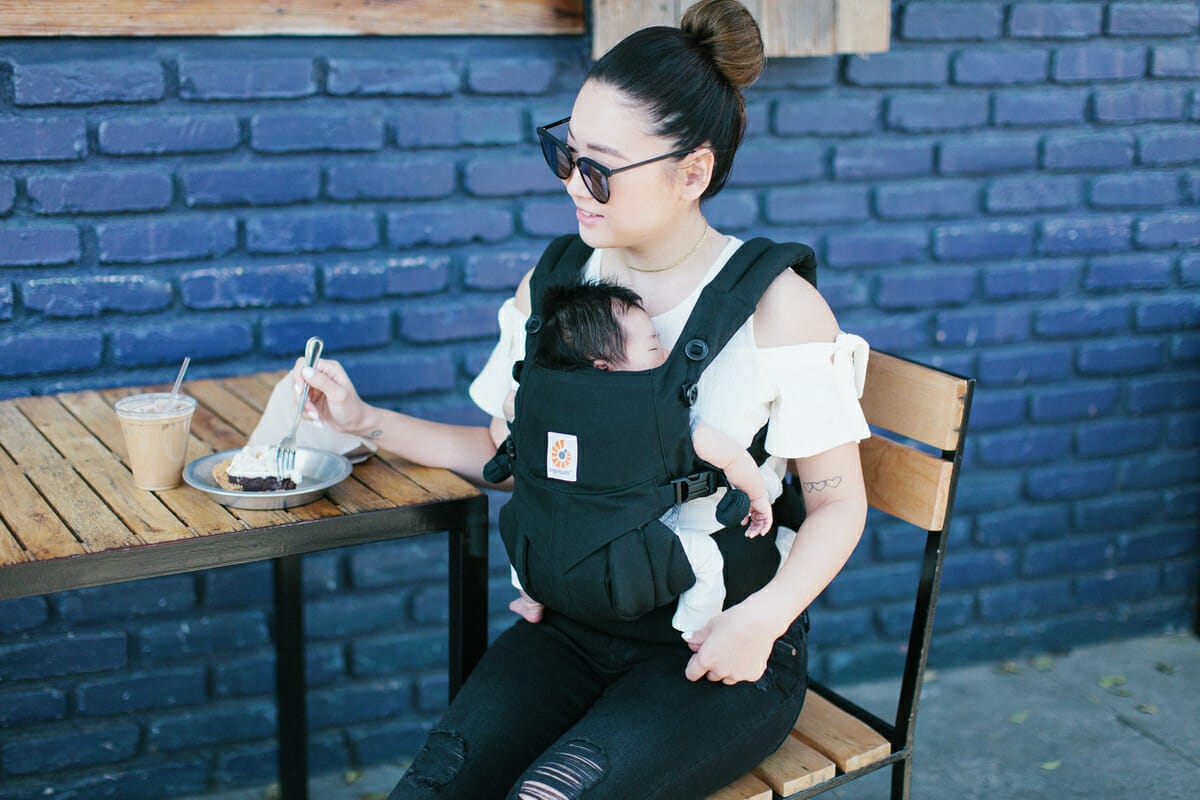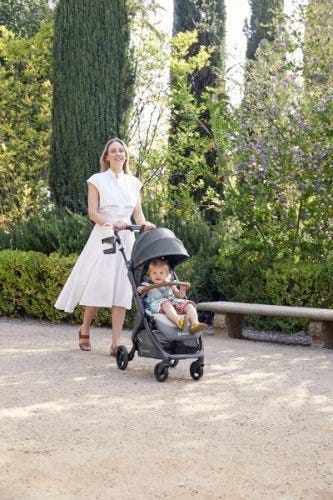
Babywearing is helpful for when you want to hold a baby and have your hands free, and can be more convenient than a stroller when out and about. But did you know that babywearing can also help with postpartum mental illness, such as anxiety and depression?
Babywearing passively comforts a child
Symptoms of clinical postpartum anxiety, depression, or other postpartum illness, can make it hard for a parent to feel “present” let alone focus on the baby. I often suggest babywearing to my clients, and coach them to start a habit of kissing the baby’s head, and letting the baby cuddle. Even a parent that feels low energy or less than 100% can passively be a loving safe-haven to their child by wearing him or her.
Wear your child to soothe your anxiety
For parents with anxiety, OCD, or fears of something being wrong with the baby, babywearing can also be an easy way to feel comfort. You can go ahead and pat the baby there on your chest as often as you like and get the comfort of feeling the baby breathing, secure knowing baby is there and safe. For a colicky baby or a baby with a difficult temperament, babywearing can minimize baby’s crying.
Babywearing can help grow our love
So, I’m just going to say it: not all mothers feel “love at first sight” for their newborn. Risks factors that can increase the chances that a new mom will not attach immediately to her baby include: • An unplanned pregnancy • Conflict with or separation from the partner • A traumatic birth • Pregnancy that is the product of rape • Any kind of resentment towards pregnancy, birth or the transition to motherhood • Maternal mental illness • Or a baby with a difficult temperament. “Aren’t you just in love?” well-meaning strangers always ask new moms. For some, no, they simply aren’t in love. At least not yet. They may be sleep-deprived, recovering physically, anxious, depressed, or resentful. Yet few will ever admit it publicly. It’s just not socially acceptable to post on Facebook. And then comes the guilt. “Am I some kind of monster that doesn’t love their child?” I like to give my clients struggling with poor attachment hope. If they don’t feel love at first sight, they can still hope to develop a loving relationship. Think of it as an arranged marriage. Many in arranged marriages grow to love each other. Some lucky ones may be attracted to each other right away, but the majority take a little bit of time and a little bit of work to reach love.
Babywearing can help grow attachment
All you really have to do is be a warm body! Make it a point to wear your baby every day. If your child tends to be fussy at a certain time a day, that is a great time to start. Other interventions for improving attachment include practicing baby massage or taking a mom and baby class. Try a babywearing dance class! One other intervention for poor mother-baby attachment is to spend 15 minutes a day totally focused on the child. Yes… that’s it. Just 15 minutes. (Side rant: How many of you feel guilty if you EVER “check out” and watch TV or surf social media on your phone? Don’t. Please don’t. It’s actually healthier to be your own person than to be a helicopter parent.)
Final thoughts
Developmental Psychology has taught us that baby humans, like baby monkeys, need a loving and well-attached mother in order to have healthy development. I don’t believe that is entirely true. Any well-attached and healthy parental figure can provide a benefit to a growing child. It does not necessarily have to be the biological mother. For dads/partners and adoptive parents, babywearing is a great way to mimic the physical closeness of pregnancy. And remember: Parenthood is a new job – look at your expectations on yourself. It takes six months, on average, to adjust to any new job – and this job keeps changing. Just when you get used to a newborn, you end up with an older baby, eating solids, crawling… And just when you feel comfortable with a sleep routine, you hit the four month sleep regression and everything goes out the window. You are doing great! Keep your head up and your baby close!
Emotional Benefits of Getting Outside
Spending time in nature with your baby can strengthen the bond between you. The simple act of holding your baby close, feeling their warmth, and sharing new experiences together can create strong emotional connections. It’s also a wonderful way to reduce stress and improve your mood. When my littles were extra fussy, I’d take a walk around the neighborhood. Even though I don't live in an area with trails and surrounded by nature, simply behind outside changed everything. A little vitamin D does wonders!
Cognitive Development
Nature is a sensory wonderland for babies. The different sights, sounds, and smells can stimulate your baby’s senses and promote cognitive development. Watching leaves rustle, hearing birds chirp, and feeling the texture of a tree bark can all contribute to their learning and development.
All About Baby Carriers for Nature Adventures
Choosing the Right Baby Carrier
When it comes to selecting the best baby carrier for summer adventures, there are several options to consider.
Types of Baby Carriers:
- Wraps: Perfect for newborns, providing a snug and secure fit.
- Slings: Ideal for quick and easy use, offering good ventilation.
- Soft Structured Carriers: Versatile and comfortable for both parent and baby, suitable for longer trips.
Factors to Consider:
- Baby’s Age and Weight: Ensure the carrier is appropriate for your baby’s size and weight. For example, Ergobaby’s Embrace Newborn Carrier is perfect for the fourth trimester where baby is small and you’re looking for an easy way to stay close. As they grow, you’ll want to upgrade to an all-position carrier that’s meant for growing babies.
- Parent’s Comfort and Ergonomics: Look for carriers with padded shoulder straps and lumbar support if you’re planning on longer outings.
- Ease of Use: Choose a carrier that is easy to put on and take off.
- Climate and Breathability: Opt for carriers made of breathable fabrics to keep you and your baby cool in hot weather.
Safety Tips:
- Proper Positioning: Ensure your baby is seated correctly, with their legs in an "M" position and their head should be close enough to kiss.
- Checking for Wear and Tear: Regularly inspect your carrier for any signs of damage.
- Ensuring Adequate Support: Make sure the carrier provides proper support for your baby’s head and neck.
Exploring Nature with a Baby Carrier
Ideal Spots for a Nature Walk with Baby
- Parks and Gardens: Great for leisurely walks and picnics.
- Nature Trails and Forests: Perfect for more adventurous outings.
- Beaches and Lakesides: Wonderful for enjoying the water and sand, with the right carrier.
Activity Ideas
- Hiking: Enjoy a scenic hike with a hiking baby carrier that offers support and storage.
- Bird Watching: Use your carrier to keep your baby close while you explore and observe wildlife.
- Picnics: A carrier can free up your hands, making it easier to carry picnic supplies.


Advantages of Using Strollers for Nature Adventures


While baby carriers are fantastic for mobility and closeness, depending on the adventure of choice you might want to be a stroller along too.
There are a LOT of baby stroller options on the market. So we understand how confusing it can be to choose the one that’s right for your family. Not only are there a variety of brands, but a variety of strollers that serve different purposes.
There are a few types of strollers on the market:
- Full-sized stroller: This is typically the stroller parents thing of buying for all its versatility.
- Lightweight or umbrella stroller:These compact strollers are perfect for on-the-go adventures.
- Jogging stroller: Designed for parents who want to combine fitness with outdoor adventures.
- Double stroller: Designed for parents with multiple kids, especially twins.
- Car seat carrier: These strollers connect to a specific car seat. We don't typically recommend these as they can be unsafe for baby and uncomfortable for parents who are pushing.
Learn more about the types of strollers and which one would be best for you.
Benefits of Bringing a Stroller
- Storage Space for Gear: Ample room for carrying all your essentials like a diaper bag, beach toys and more.
- Shade and Weather Protection: Built-in canopies to shield your baby from the sun when they are lounging.
- Options: If you have more than one kid, you can stroll with one and carry the other. Or, if you’re getting warm or your little one is getting fussy, you can switch up their position from stroller to carrier or vice versa.
Safety Tips for Strollers
- Ensure your stroller is in good working condition. Make sure buckles are still buckling and that there are no rips or holes that could compromise your baby’s safety.
- Use sunshades or bug nets to protect your little one’s skin.
- Securing the baby properly: always buckle up your baby for safety even if you think they are old enough to go without the buckle.
Combining Baby Carriers and Strollers
For the ultimate flexibility, consider using both a baby carrier and a stroller on your outings.
Combining both options allows you to adapt to different situations. Use the carrier for more rugged trails and switch to the stroller for smoother paths or when your baby needs a nap.
Transition Tips
- Smooth Transitions: Plan stops where you can easily switch from carrier to stroller.
- Pack Light: Only bring essentials to make transitions easier.
Tips for a Successful Adventure
Planning Ahead
- Route Planning: Choose baby-friendly trails and parks. Check local mom groups or outdoor groups and get recommendations for the best outings for kids.
- Check Weather Conditions: Avoid extreme heat or unpredictable weather. Even with our most breathable carriers, when it’s hot, it’s hot. And having two bodies against each other in the heat will be naturally hot and sticky already.
- Packing Checklist: Include diapers, snacks, water, sunscreen, and a first-aid kit. These all-position carriers have storage pockets where you can fit some of the items easily!
- Stay Hydrated and Nourished: Pack healthy snacks to keep energy levels up and bring plenty of water for both you and baby.


Summer adventures with your baby are a wonderful way to create lasting memories and enjoy the beauty of nature together. From baby carriers to strollers, Ergobaby products are designed to provide comfort and ease for both you and your little one. So, gear up, get outside, and explore the world with your baby by your side.
Ready to embark on your own summer adventures? Check out Ergobaby’s range of baby carriers and strollers to find the perfect match for your family’s needs. Visit our website today and start planning your next outdoor excursion!



























